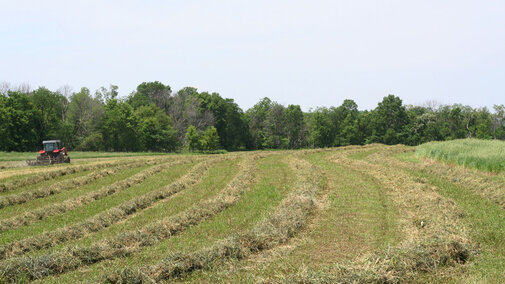When to Cut Hay
By Brad Schick
Bromegrass is headed out and native meadows are beginning to grow rapidly with warmer temperatures the past couple weeks. Is now the time to make grass hay?
Sometimes a simple date on the calendar is the reason hay is cut. Some will cut when it works in their operation — after corn is fertilized or sprayed, after branding or turning out to summer grass, maybe after kids’ baseball and softball seasons are over. Tradition and schedules play a key role in management decisions, but should we consider another factor?
An important, yet often overlooked, way to determine when to cut is what quality of hay is needed on the operation. Is a protein source needed to minimize supplementation? Is simple roughage needed? Will it be sold? Can it be sold at a premium for being higher quality? Each operation is different and has different needs.
Right now the quality of bromegrass and other cool-season grasses are rapidly declining. As these plants mature and become stemmy, their protein, energy content and digestibility decrease. Studies have shown that grass hay cut at early heading could result in a daily gain of one pound for bred heifers, whereas the same mature hay may not even meet the requirements of a dry cow.
When deciding when to cut or what field to cut, first determine what livestock will consume the hay and plan accordingly.
A little change to the timing of haying might better meet livestock nutrient requirements and reduce supplementation costs.
Controlling Bluegrass in Irrigated Alfalfa
Bluegrass can be a common weed in irrigated alfalfa lowering forage quality and shortening stand longevity. Fortunately, there are several ways to control these pesky plants such as maintaining thick alfalfa stands, properly managing irrigation and using herbicides (as a last resort).
High-density alfalfa stands can be effective toward competing with bluegrass for sunlight, moisture and nutrients. However, it is important to time irrigation so the upper several inches of fields are dry at harvest. Then delay irrigation until significant alfalfa regrowth is initiated. Unlike alfalfa that has a deep root system, bluegrass is shallow rooted and will not compete well with the alfalfa if the topsoil is dry. Conversely, early irrigation following harvest may allow bluegrass to out-compete the alfalfa for available surface moisture, since bluegrass basal leaves help it grow more rapidly after alfalfa is cut. Once alfalfa gets some regrowth, it will compete well with the bluegrass.
If stands are thick and water management is adequate, then herbicides like Butyrac 200® + Raptor®; Warrant®; Select Max®; Arrow®; Prowl H2O®; Chateau® or Roundup WeatherMax® might be cost effective to weaken or kill bluegrass. Apply any one of these immediately after harvest. RoundUp® herbicides can be used on Round-up Ready® alfalfa fields. Select Max® herbicide may work the best for non-Roundup Ready alfalfa varieties and is safe for all alfalfa fields.
Bluegrass is a problem in many irrigated alfalfa fields, but it doesn’t need to be. Using proper management, you can control it.
High Density Stocking
Warm temperatures have pushed many cool-season grasses to maturity quickly, ahead of our grazing rotations. Can changing your grazing strategy help use this mature forage more efficiently?
A big pasture management challenge is keeping grass from heading out, becoming less palatable and low quality. If we rotate animals the same as earlier in the year with all the headed-out grass, animals will strip some leaves, trample a lot of forage, and leave most of the stems standing. They will probably end up eating less than one-fourth of the potential forage available.
With forage looking like a valuable commodity this year, getting animals to eat a bit more now by limiting how much choice they have could be beneficial. Instead of giving them the entire paddock to graze, use electric fence to limit them to very tiny areas at a time.
How tiny you ask? Well, one possible initial goal would be to put the equivalent of about 250,000 pounds of cattle on just one acre, about 150 to 200 cow-calf pairs per acre. Obviously, it won’t take them long to finish off that small area, so expect to give them a fresh strip as many as three times a day. With the high density of animals, grazing distribution will be more uniform and you could see an improvement in grazing efficiency.
Keep an eye on animal condition and adjust the paddock as necessary to find a good balance between grazing efficiency and meeting nutritional demands, especially with growing animals and those with high nutrient demands from lactation.
Getting water to the animals can also be a challenge, so I suggest letting them walk back to water over previously grazed strips for a couple days before changing water locations. It will take a little adjustment to get just the right size and water placement, but after a couple days it should go smoothly.
If all goes well, you’ll get more cow-days of grazing with less waste.

